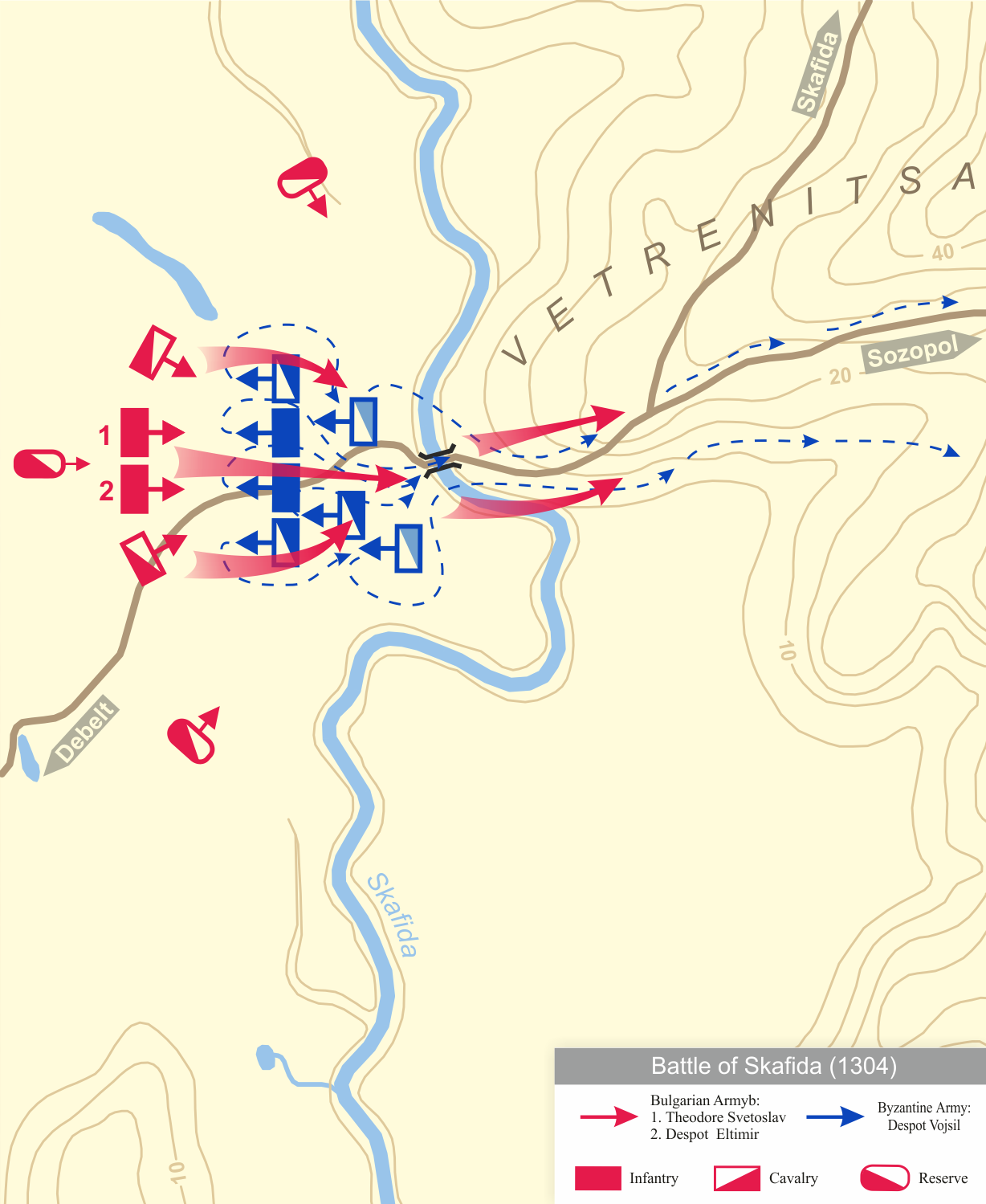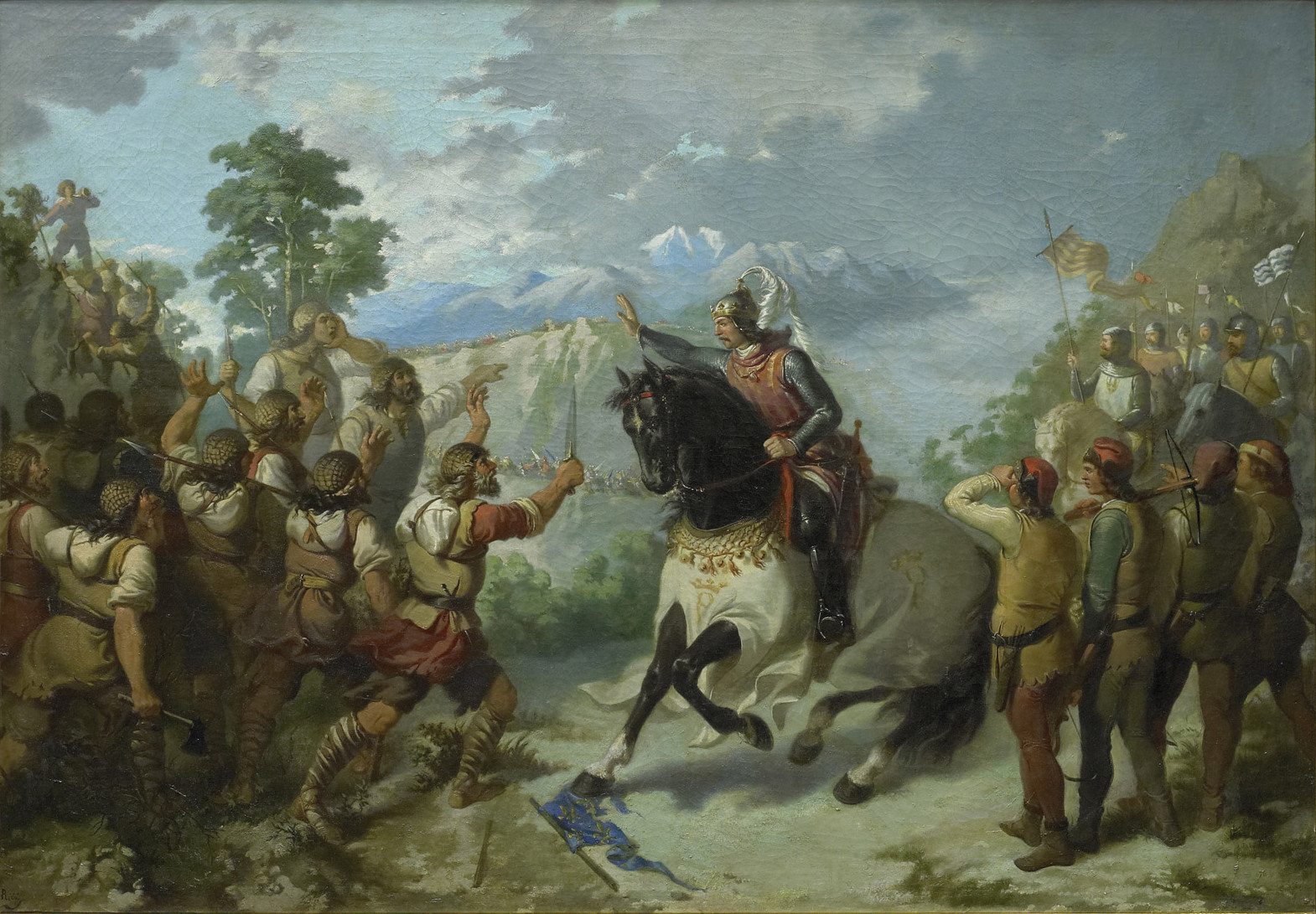|
1305
Year 1305 ( MCCCV) was a common year starting on Friday (link will display the full calendar) of the Julian calendar. Events By place Byzantine Empire * April 30 – Co-Emperor Michael IX (Palaiologos) invites Roger de Flor, Italian nobleman and adventurer, to Adrianople and has him assassinated there. Along with de Flor, 300 horsemen and some 1,000 foot soldiers who accompanied him are killed. The plan is executed by Alan mercenaries, who at that time are enlisted in the Byzantine army. The murder of the commander of the Catalan Company does not have the expected results. Not only is the Company not disbanded, but its attacks on Byzantine territory becomes more severe. The period of destruction in Macedonia and Thrace after the murder of de Flor becomes known as the "Catalan Revenge". * July – Battle of Apros: Byzantine forces (some 6,000 men) under Michael IX (Palaiologos), consisting of a large contingent of Alans and Turcopoles (Christianized Tur ... [...More Info...] [...Related Items...] OR: [Wikipedia] [Google] [Baidu] |
Wenceslaus II Of Bohemia
Wenceslaus II Přemyslid ( cs, Václav II.; pl, Wacław II Czeski; 27 SeptemberK. Charvátová, ''Václav II. Král český a polský'', Prague 2007, p. 18. 1271 – 21 June 1305) was King of Bohemia (1278–1305), Duke of Cracow (1291–1305), and King of Poland (1300–1305). He was the only son of King Ottokar II of Bohemia and Ottokar's second wife Kunigunda. He was born in 1271, ten years after the marriage of his parents. Kunigunda was the daughter of Rostislav Mikhailovich, lord of Slavonia, son of a Grand Prince of Kiev, and Anna of Hungary, daughter of Béla IV of Hungary. His great-grandfather was the German king Philip of Swabia. Wenceslaus II was the grandfather of the Holy Roman Emperor, Charles IV. He was a member of the Přemyslid dynasty. Early years In 1276 Rudolf I, King of the Romans, placed Ottokar under the ban of the empire and besieged Vienna. This compelled Ottokar in November 1276 to sign a new treaty by which he gave up all claims to Austria ... [...More Info...] [...Related Items...] OR: [Wikipedia] [Google] [Baidu] |
Wenceslaus III Of Bohemia
Wenceslaus III ( cz, Václav III., hu, Vencel, pl, Wacław, hr, Vjenceslav, sk, Václav; 6 October 12894 August 1306) was King of Hungary and Croatia between 1301 and 1305, and King of Bohemia and Poland from 1305. He was the son of Wenceslaus II, King of Bohemia, who was later also crowned king of Poland, and Judith of Habsburg. Still a child, Wenceslaus was betrothed to Elizabeth, the sole daughter of Andrew III of Hungary. After Andrew III's death in early 1301, the majority of the Hungarian lords and prelates elected Wenceslaus king, although Pope Boniface VIII supported another claimant, Charles Robert, a member of the royal house of the Kingdom of Naples. Wenceslaus was crowned king of Hungary on 27 August 1301. He signed his charters under the name Ladislaus in Hungary. His rule was only nominal, because a dozen powerful lords held sway over large territories in the kingdom. His father realized that Wenceslaus's position could not be strengthened and took him ba ... [...More Info...] [...Related Items...] OR: [Wikipedia] [Google] [Baidu] |
William Wallace
Sir William Wallace ( gd, Uilleam Uallas, ; Norman French: ; 23 August 1305) was a Scottish knight who became one of the main leaders during the First War of Scottish Independence. Along with Andrew Moray, Wallace defeated an English army at the Battle of Stirling Bridge in September 1297. He was appointed Guardian of Scotland and served until his defeat at the Battle of Falkirk in July 1298. In August 1305, Wallace was captured in Robroyston, near Glasgow, and handed over to King Edward I of England, who had him hanged, drawn and quartered for high treason and crimes against English civilians. Since his death, Wallace has obtained an iconic status far beyond his homeland. He is the protagonist of Blind Harry's 15th-century epic poem '' The Wallace'' and the subject of literary works by Jane Porter and Sir Walter Scott, and of the Academy Award-winning film '' Braveheart''. Background William Wallace was a member of the lesser nobility, but little is definitely known of ... [...More Info...] [...Related Items...] OR: [Wikipedia] [Google] [Baidu] |
Otto III, Duke Of Bavaria
Otto III (11 February 1261 – 9 November 1312), a member of the Wittelsbach dynasty, was the Duke of Lower Bavaria from 1290 to 1312 and the King of Hungary and Croatia between 1305 and 1307. His reign in Hungary was disputed by Charles Robert of the Angevin dynasty. Family Otto was born in Burghausen, the son of Henry XIII, Duke of Bavaria, and Elizabeth of Hungary. Biography Otto succeeded his father in 1290 as duke of Lower Bavaria, together with his younger brothers, Louis III and Stephen I. He was in opposition to Habsburg and tried to regain Styria which Bavaria had lost in 1180. Otto supported Adolf, King of Germany against Habsburg and fought on his side in the Battle of Göllheim. The Hungarian crown was offered to Otto, a grandson of Béla IV of Hungary, in 1301 but he did not accept before 1305. In August 1305, his opponent, Wenceslaus III of Bohemia, who had inherited Bohemia from his father, renounced his claim to Hungary on behalf of Otto III. Since the Hab ... [...More Info...] [...Related Items...] OR: [Wikipedia] [Google] [Baidu] |
Battle Of Apros
The Battle of Apros occurred between the forces of the Byzantine Empire, under co-emperor Michael IX Palaiologos, and the forces of the Catalan Company, at Apros on July 1305. The Catalan Company had been hired by the Byzantines as mercenaries against the Turks, but despite the Catalans' successes against the Turks, the two allies distrusted each other, and their relationship was strained by the Catalans' financial demands. Eventually, Emperor Andronikos II Palaiologos and his son and co-ruler Michael IX had the Catalan leader, Roger de Flor, assassinated with his entourage in April 1305. In July, the Byzantine army, comprising a large contingent of Alans as well as many Turcopoles, confronted the Catalans and their own Turkish allies near Apros in Thrace. Despite the Imperial Army's numerical superiority, the Alans withdrew after the first charge, whereupon the Turcopoles deserted ''en block'' to the Catalans. Prince Michael was injured and left the field and the Catalans w ... [...More Info...] [...Related Items...] OR: [Wikipedia] [Google] [Baidu] |
Viola Of Teschen
Viola of Teschen, later known as Viola Elizabeth ( pl, Wiola Elżbieta cieszyńska, cs, Viola Alžběta Těšínská) (ca. 1291 – 21 September 1317), was Queen of Bohemia and Poland by marriage to Wenceslaus III of Bohemia. She was daughter of Mieszko I, Duke of Cieszyn, by his unknown wife. She was named after her paternal great-grandmother Viola, wife of Duke Casimir I of Opole. Life Queen of Bohemia and Poland Viola married with young King Wenceslaus III of Bohemia and Poland on 5 October 1305 in Brno. The reasons for marriage are not too obvious: although later chroniclers describe how beautiful Viola was, her father Duke Mieszko I was only one of the vassals of King Wenceslaus III, and in consequence, this was an unequal union. The main reason wasn't her beauty but maybe the strategic position of Cieszyn between the Kingdoms of Bohemia and Poland. Four days after the wedding (9 October), Wenceslaus III annulled his long-time engagement to Elizabeth, daughter of King An ... [...More Info...] [...Related Items...] OR: [Wikipedia] [Google] [Baidu] |
Roger De Flor
Roger de Flor (1267 – 30 April 1305), also known as Ruggero/Ruggiero da Fiore or Rutger von Blum or Ruggero Flores, was an Italian military adventurer and condottiere active in Aragonese Sicily, Italy, and the Byzantine Empire. He was the commander of the Great Catalan Company and held the title Count of Malta. Biography Roger de Flor was born in Brindisi in the Kingdom of Sicily, the second son of an Italian noblewoman of Brindisi and a German falconer named Richard von Blum (''Blume'' means flower in German) in the service of Emperor Frederick II. Richard von Blum was killed fighting at the Battle of Tagliacozzo in 1268. At eight years old Roger de Flor was sent to sea in a galley belonging to the Knights Templars. He entered the order and became captain of a galley called "El falcó". After rescuing wealthy survivors during the siege of Acre by the Mamluk Sultan Al-Ashraf Khalil in 1291, he went to Cyprus. Following intrigues and personal disputes he was accused ... [...More Info...] [...Related Items...] OR: [Wikipedia] [Google] [Baidu] |
Michael IX Palaiologos
, image = 154 - Michael IX Palaiologos (Mutinensis - color).png , caption = 15th-century portrait of Michael IX (from a 15th-century codex containing a copy of the ''Extracts of History'' by Joannes Zonaras) , succession = Byzantine emperor , reign = 21 May 1294 –12 October 1320 , coronation = 21 May 1294, Hagia Sophia , regent = Andronikos II Palaiologos , reg-type = Co-emperor , predecessor = Andronikos II (alone) , successor = Andronikos II (alone), Andronikos III ( in Macedonia) , spouse = , issue = , dynasty = Palaiologos , father = Andronikos II Palaiologos , mother = Anna of Hungary , birth_date = 17 April 1277 , birth_place = Constantinople(now Istanbul, Turkey) , death_date = , death_place = Thessaloniki, Greece , place of burial = , , title= Emperor and Autocrat of the Romans Michael IX Palaiologos or Palaeologus ( el, Μιχαήλ Δού ... [...More Info...] [...Related Items...] OR: [Wikipedia] [Google] [Baidu] |
Catalan Company
The Catalan Company or the Great Catalan Company (Spanish: ''Compañía Catalana'', Catalan: ''Gran Companyia Catalana'', Latin: ''Exercitus francorum'', ''Societas exercitus catalanorum'', ''Societas cathalanorum'', ''Magna Societas Catalanorum'') was a company of mercenaries led by Roger de Flor in the early 14th century and hired by the Byzantine Emperor Andronikos II Palaiologos to combat the increasing power of the Anatolian beyliks. It was formed by ''almogavar'' veterans of the War of the Sicilian Vespers, who had remained unemployed after the signing in 1302 of the Peace of Caltabellotta between the Crown of Aragon and the French dynasty of the Angevins. Origin The military demands of the Reconquista stimulated the formation of the elite light infantry known as the '' almogavars'' on the Iberian peninsula during the 13th century. These troops were used quite effectively by the Crown of Aragon for other imperial ventures in the Mediterranean, particularly the War ... [...More Info...] [...Related Items...] OR: [Wikipedia] [Google] [Baidu] |
Mieszko I, Duke Of Cieszyn
Mieszko I of Cieszyn ( pl, Mieszko cieszyński, cs, Měšek I. Těšínský, german: Mesko I (Teschen); also known as Mieszko I of Opole; 1252/56 – by 27 June 1315), was a Duke of Racibórz during 1282–1290 (with his brother as co-ruler) and the first Duke of Cieszyn since 1290 until his death. He was the oldest son of Władysław, Duke of Opole- Racibórz, by his wife Euphemia, daughter of Władysław Odonic, Duke of Greater Poland. Life Early years Little is known about the early years of Mieszko I's life. His first documented mention was on 21 October 1258, when he appears together with his father and two younger brothers in the consent of the foundation of a Cistercian abbey in Rudy. Duke of Racibórz After his father's death in 1282, and according to the custom during the fragmentation of Poland, Mieszko and his brothers divided the Duchy of Opole-Racibórz between them: Mieszko and his youngest brother Przemysław received together the district of Racibórz as ... [...More Info...] [...Related Items...] OR: [Wikipedia] [Google] [Baidu] |
Władysław I Łokietek
Władysław I Łokietek, in English known as the "Elbow-high" or Ladislaus the Short (c. 1260/12 March 1333), was King of Poland from 1320 to 1333, and duke of several of the provinces and principalities in the preceding years. He was a member of the royal Piast dynasty, the son of Duke Casimir I of Kuyavia, and great-grandson of High-Duke Casimir II the Just. Władysław I inherited a small portion of his father's domain, but his dominion grew as some of his brothers died young. He unsuccessfully tried to incorporate the Duchy of Krakow (the Seniorate Province) in 1289, following the death of his half-brother Leszek II the Black and the withdrawal from contention of his ally Bolesław II of Masovia. After a period in exile during the rule of Wenceslaus II, Władysław regained several duchies and then Krakow in 1306 when Wenceslaus III was murdered. He temporarily took control of part of Greater Poland after the death of his ally Przemysł II, lost it, and then subsequentl ... [...More Info...] [...Related Items...] OR: [Wikipedia] [Google] [Baidu] |
Prague
Prague ( ; cs, Praha ; german: Prag, ; la, Praga) is the capital and largest city in the Czech Republic, and the historical capital of Bohemia. On the Vltava river, Prague is home to about 1.3 million people. The city has a temperate oceanic climate, with relatively warm summers and chilly winters. Prague is a political, cultural, and economic hub of central Europe, with a rich history and Romanesque, Gothic, Renaissance and Baroque architectures. It was the capital of the Kingdom of Bohemia and residence of several Holy Roman Emperors, most notably Charles IV (r. 1346–1378). It was an important city to the Habsburg monarchy and Austro-Hungarian Empire. The city played major roles in the Bohemian and the Protestant Reformations, the Thirty Years' War and in 20th-century history as the capital of Czechoslovakia between the World Wars and the post-war Communist era. Prague is home to a number of well-known cultural attractions, many of which survived ... [...More Info...] [...Related Items...] OR: [Wikipedia] [Google] [Baidu] |





